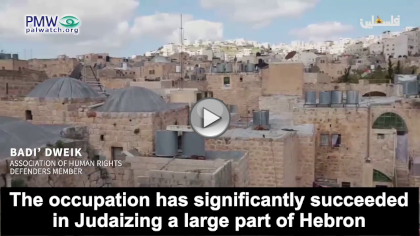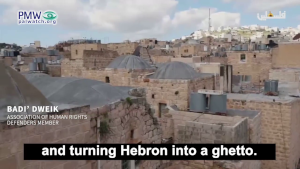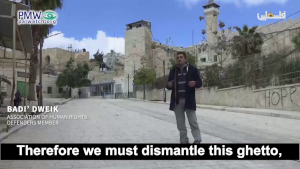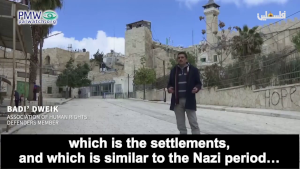Hijacking Holocaust terminology to perpetuate falsities and demonize Israel
An integral part of the Palestinian Authority messaging is to adopt terminology associated with the actions of the Nazis towards the Jews of Europe during the Holocaust, and to claim that Israel is conducting the same actions against the Palestinians.
Echoing the PA messaging, a claim of this nature, accusing Israel of “Judaizing” the town of Hebron and turning it into a Nazi style ghetto was recently made on official PA TV by a Palestinian from Hebron, Badi’a Dweik, who presents himself as a “human rights defender.” Dweik continued by claiming that there is no “apartheid” in the world like that he claims exists in Hebron.
“The occupation has significantly succeeded in Judaizing a large part of Hebron and turning Hebron into a ghetto. Therefore we must dismantle this ghetto, which is the settlements, and which is similar to the Nazi period… I have twice visited South Africa, to which apartheid is compared in the world. I also went to Northern Ireland, which is occupied by Britain. There is no apartheid like there is in Hebron… There is nothing like it in the entire world.”
[Official PA TV, Lovers of the Land, March 1, 2021]
In order to fully understand the depths of this libel, it is important to provide a historical, factual and comparative context.
The Jewish connection to Hebron
Jews have lived in Hebron on an almost continuous basis for over 3,000 years, only leaving the town when expelled by the periodical foreign invaders. While King David is often exclusively associated with Jerusalem, in fact, he was anointed King over all Israel, in Hebron.
The Jewish presence in Hebron in the last 500 years, with the exception of the years 1948 to 1967 when the city was occupied by Jordan, is well documented.
The main synagogue in the Jewish area of Hebron, the "Abraham Our Father" synagogue, was built in 1540, shortly after the town came under the rule of the Ottoman empire. Many of the Jews of Hebron left the town in 1929, after Arabs murdered 67 of the town's Jews, including children and babies, and mutilated their bodies. The PA regularly glorifies the most cruel of the participants in the 1929 massacre, who were executed by the British government because of the particular brutality of their crimes.
Today’s Jewish presence in Hebron is extremely limited and confined predominantly to some of the buildings and land that were owned by Jews prior to their expulsion by the Jordanians in 1948 and to buildings purchased since 1967 by Israelis. While additional land and buildings in Hebron are Jewish owned, the owners are awaiting final government permission to rebuild and inhabit these structures.
According to the Israeli government, in 1996 there were 500 Jews and 120,000 Arabs living in Hebron. While the Jewish population of Hebron has not grown substantially, according to the PA Central Bureau of Statistics the Arab population living in Hebron has grown to 215,000 people.
Given the extensive connection of the Jewish people to the town of Hebron, which spans more than three millennia, it is clearly false to claim that anyone is “Judaizing” Hebron, simply on the basis of 500 Jews living in properties that have been under Jewish ownership for over 100 years.
For a more extensive overview of the Jewish history and connection to Hebron see below, which is based on information provided on the website of Israel’s Ministry of Foreign Affairs.
Is Arab Hebron a “ghetto that is similar to the Nazi period,” as claimed by the speaker on official PA TV?
In order to answer this question, it is sufficient to make some basic, but fundamental comparisons between Hebron and the Warsaw ghetto.
| The Warsaw Ghetto | Arab Hebron |
| The Warsaw ghetto was enclosed by a wall that was over 10 feet high, topped with barbed wire. | No wall limits Arab Hebron. |
| The Nazis forced Jews from the surrounding area of Warsaw to enter the ghetto. | No Israeli requirement forces anyone to live in Hebron. |
| In the Warsaw ghetto, 400,000 Jews were forced to live in an area of 1.3 square miles with an average of 7.2 persons per room. | According to a census of the PA Central Bureau of Statistics, in 2019 the average number of persons per room in Hebron was 1.4. |
| In the Warsaw ghetto, food allotments were rationed by the German civilian authorities and were not sufficient to sustain life. In 1941 the average Jew in the ghetto subsisted on 1,125 calories a day. | Israel does not restrict the amount of food in Hebron in any way, shape or form. |
| From July 22 until September 12, 1942, the Nazis carried out mass deportations from the Warsaw ghetto to the Treblinka death camp. During this period, the Germans deported about 265,000 Jews from Warsaw to Treblinka; they killed approximately 35,000 Jews inside the ghetto during the operation. | Aside from Israel’s restrictions on activities connected to terror, Arab residents of Hebron are free and are thriving. According to the PA Central Bureau of Statistics, the number of residents in the entire Hebron region Governorate has doubled in the last 23 years, growing from 385,165 people in 1997 to 762,541 people in 2020. In the town of Hebron itself, in just the last four years, the number of residents has grown from 199,319 people in 2017 to 215,571 people in 2020. |
Below are additional details regarding the Warsaw ghetto taken from the website of the United States Holocaust Memorial museum.
While the ghettoes into which the Nazis herded the Jews of Europe were a place of death and destruction, the Chamber of Commerce and Industry in Hebron, describe glowingly the city’s industry as follows:
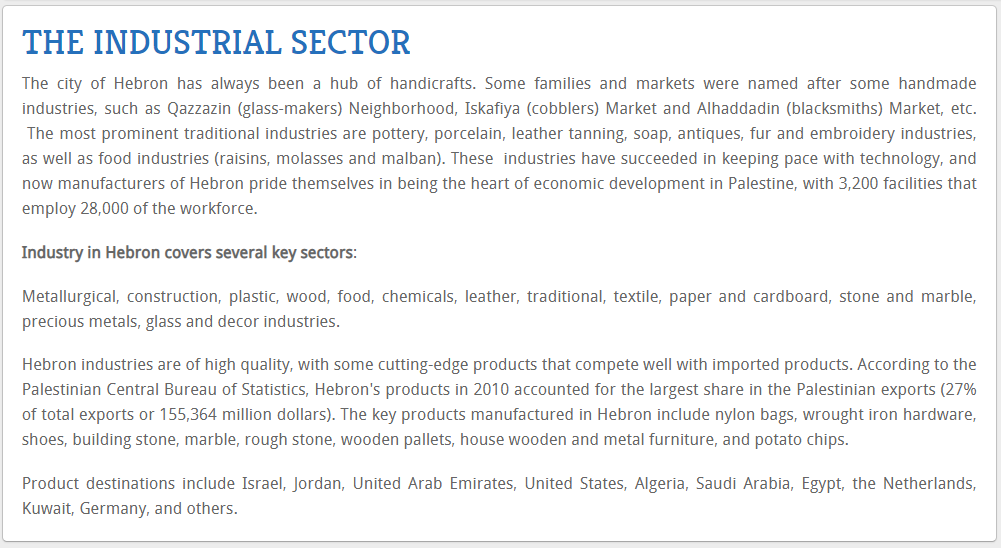
The 1997 Hebron protocol
In 1997, as part of the Oslo Accords, control over the city of Hebron was divided between Israel (H2) and the Palestinian Authority (H1).
While the PA-controlled areas of Hebron are devoid of any Israelis, thousands of Palestinians are resident in the section of the city under Israeli control.
The following are illustrations of the division of control:
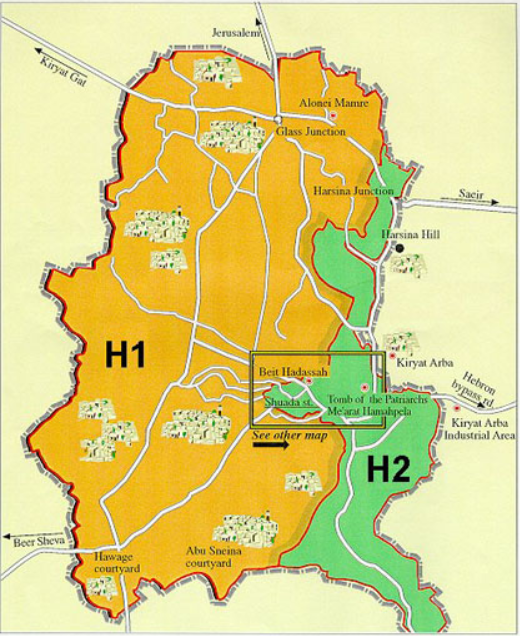
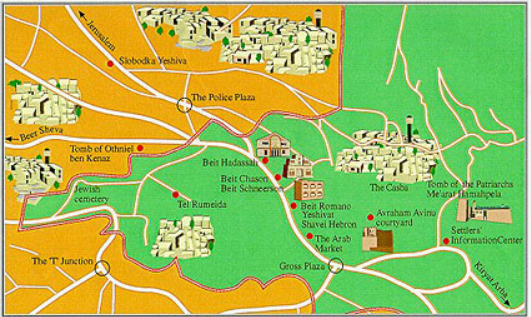
[Website of Israel’s Ministry of Foreign Affairs]
While Israelis are barred from entering the areas of Hebron under PA control, Palestinians can move freely, with only minor exceptions, within the area under Israeli control.
The restrictions on movement that do exist in the Israeli-controlled area are not based on race, color or creed, but rather reflect security precautions that have been implemented to mitigate the threat of terrorism.
Indeed, Hebron has been the site of heinous acts of terror, including the 1929 Arab massacre of the Jews, the 1980 murder of 6 Jews by Palestinians, the 1994 murder of 29 Palestinians by an Israeli and the 2001 murder of baby Shalhevet Pass.
It’s important to note how these acts and their perpetrators are perceived.
As noted above, instead of denouncing the 1929 massacre, the PA has adopted some of its worst murderers, glorifying them on a constant basis, referring to them as “heroes” who “will remain a symbol of pride, honor, and greatness, and will remain an example for the Palestinian people.”
Similarly, instead of distancing itself from the 1980 murder, Fatah, the party of PA chairman Mahmoud Abbas, promoted the candidacy of one of the murderers, Tayseer Abu Sneineh, for mayor of Hebron.
Announcing Abu Sneineh’s candidacy, Fatah described the terror attack against civilians as “one of the most important battles and acts of bravery of the Fatah Movement” and “one of the most courageous self-sacrifice operations” and referred to the killers as “heroes” and men “of delicate emotions”:
“Four young people met on one of the cold days of March 1980 in a cave in the Hebron hills... on that very day the four were unknown...
After a few months, the four carried out one of the most courageous self-sacrifice operations in the occupied areas, if not the most courageous, and it is the attack against the Jewish settlers in Hebron...
The four heroes were not murderers, who feel a sense of enjoyment and satisfaction from the sight of blood, but rather [men] of delicate emotions, who the extremist Zionist occupiers denied the rights of their Palestinian people, and they did not find any other means besides weapons in order to restore them [the rights]...”[Official Fatah Facebook page, Aug. 27, 2016]
The PA and Fatah have similarly embraced the terrorists responsible for the murder of baby Shalhevet Pass who was murdered while laying in her stroller.

Marwan Zalum, the terrorist who ordered the attack is the subject of constant adulation. As part of the PA’s Pay for-Slay, terror reward policy, Mahmoud Amru, the sniper who murdered baby Shalhevet, has received a monthly salary from the PA since his arrest in December 2002. To date, the PA has paid Amru no less than 838,800 shekels ($254,480), purely as a reward for murdering a Jewish baby.
In contrast, with the exception of a few fringe supporters, Israeli society unequivocally denounces the Israeli murderer of the Palestinians in 1994, Baruch Goldstein and his actions (see below).
As demonstrated, the claim that Israel is “Judaizing a large part of Hebron and turning Hebron into a ghetto… similar to the Nazi period,” can only be described as totally libelous hate speech.
Finally, the comparison to Apartheid is similarly lacking any real factual basis, as noted by Jacques De Maio, in April 2017, while serving as the head of the International Committee of the Red Cross delegation to Israel and the Palestinian Authority:
“No, there is no apartheid here, no regime of superiority of race, of denial of basic human rights to a group of people because of their alleged racial inferiority.”
[Ynetnews.com, 26/4/2017]
Palestinian Media Watch has extensively documented the PA’s outlook on the Holocaust, from claiming that Hitler was sent by Allah to punish the Jews; that the Holocaust was merely Europe repaying Jews for their “wickedness”; that Jews' "social role... usury" caused "massacres every 10 to 15 years" and the Holocaust and that Jews were hated because of their own behavior; through using images of bodies in Nazi concentration camps and attributing them alleged Israeli “massacres” of Palestinians.
The following is a longer excerpt of the interview with Badi’a Dweik, an expanded history of the Jewish connection to Hebron and a broader explanation regarding the Warsaw ghetto.
Official PA TV program Lovers of the Land, on Hebron
Association of Human Rights Defenders member Badi’a Dweik: “The occupation has significantly succeeded in Judaizing a large part of Hebron and turning Hebron into a ghetto, and therefore we must dismantle this ghetto, which is the settlements, and which is similar to the Nazi period…
I have twice visited South Africa, to which apartheid is compared in the world. I went to South- I also went to the northern part of Ireland, which is occupied by Britain. There is no apartheid like there is in Hebron. Hebron is the capital of apartheid, and the apartheid that is being carried out in Hebron is tantamount to a mosaic of apartheid. There is nothing like it in the entire world. That is the case according to the testimony of activists who arrived in 2009 from South Africa to examine the apartheid policy in Hebron. They said that the apartheid in Hebron is worse than what was in South Africa.”
[Official PA TV, Lovers of the Land, March 1, 2021]
The History of the Jewish presence in Hebron
Biblical period to 1967
Hebron is mentioned 87 times in the Bible, and is the world's oldest Jewish community. The city's history has been inseparably linked with the Cave of Machpelah, which the Patriarch Abraham purchased from Ephron the Hittite for 400 silver shekels (Genesis 23), as a family tomb. As recorded in Genesis, the Patriarchs Abraham, Isaac, and Jacob, and the Matriarchs Sarah, Rebecca and Leah, are buried there, and -- according to a Jewish tradition -- Adam and Eve are also buried there.
Joshua assigned Hebron to Caleb from the tribe of Judah (Joshua 14:13-14), who subsequently led his tribe in conquering the city and its environs (Judges 1:1-20). As Joshua 14:15 notes, "the former name of Hebron was Kiryat Arba..."
Following the death of King Saul, God instructed David to go to Hebron, where he was anointed King of Judah (II Samuel 2:1-4). A little more than 7.5 years later, David was anointed King over all Israel, in Hebron (II Samuel 5:1-3).
The city was part of the united kingdom and -- later -- the southern Kingdom of Judah, until the latter fell to the Babylonians in 586 BCE. Despite the loss of Jewish independence, Jews continued to live in Hebron (Nehemiah 11:25), and the city was later incorporated into the (Jewish) Hasmonean kingdom by John Hyrcanus. King Herod (reigned 37-4 BCE) built the base of the present structure -- the 12 meter high wall -- over the Tomb the Patriarchs.
The city was the scene of extensive fighting during the Jewish Revolt against the Romans (65-70, see Josephus 4:529, 554), but Jews continued to live there after the Revolt, through the later Bar Kochba Revolt (132-135 CE), and into the Byzantine period. The remains of a synagogue from the Byzantine period have been excavated in the city, and the Byzantines built a large church over the Tomb of the Patriarchs, incorporating the pre- existing Herodian structure.
Jews continued to live in Hebron after the city's conquest by the Arabs (in 638), whose generally tolerant rule was welcomed, especially after the often harsh Byzantine rule, although the Byzantines never forbade Jews from praying at the Tomb. The Arabs converted the Byzantine church at the Tomb of the Patriarchs into a mosque.
Upon capturing the city in 1100, the Crusaders expelled the Jewish community, and converted the mosque at the Tomb back into a church. The Jewish community was re-established following the Mamelukes' conquest of the city in 1260, and the Mamelukes reconverted the church at the Tomb of the Patriarchs back into a mosque. However, the restored Islamic (Mameluke) ascendancy was less tolerant than the pre-Crusader Islamic (Arab) regimes. A 1266 decree barred Jews (and Christians) from entering the Tomb of the Patriarchs, allowing them only to ascend to the fifth, later the seventh, step outside the eastern wall. The Jewish cemetery, on a hill west of the Tomb, was first mentioned in a letter dated to 1290.
The Ottoman Turks' conquest of the city in 1517 was marked by a violent pogrom which included many deaths, rapes, and the plundering of Jewish homes. The surviving Jews fled to Beirut and did not return until 1533. In 1540, Jewish exiles from Spain acquired the site of the "Court of the Jews" and built the Avraham Avinu ("Abraham Our Father") synagogue. One year, according to local legend, when the requisite quorum for prayer was lacking, the Patriarch Abraham himself appeared to complete the quorum; hence, the name of the synagogue.
Despite the events of 1517, its general poverty and a devastating plague in 1619, the Hebron Jewish community grew. Throughout the Turkish period (1517-1917), groups of Jews from other parts of the Land of Israel, and the Diaspora, moved to Hebron from time to time, joining the existing community, and the city became a rabbinic center of note.
In 1775, the Hebron Jewish community was rocked by a blood libel, in which Jews were falsely accused of murdering the son of a local sheikh. The community, which was largely sustained by donations from abroad, was made to pay a crushing fine, which further worsened its already shaky economic situation. Despite its poverty, the community managed, in 1807, to purchase a 5-dunam plot, upon which the city's wholesale market stands today, and after several years the sale was recognized by the Hebron Waqf. In 1811, 800 dunams of land were acquired to expand the cemetery.
In 1817, the Jewish community numbered approximately 500, and by 1838, it had grown to 700, despite a pogrom which took place in 1834, during Mohammed Ali's rebellion against the Ottomans (1831-1840).
In 1870, a wealthy Turkish Jew, Haim Yisrael Romano, moved to Hebron and purchased a plot of land upon which his family built a large residence and guest house, which came to be called Beit Romano. The building later housed a synagogue and served as a yeshiva, before it was seized by the Turks. During the Mandatory period, the building served the British administration as a police station, remand center, and court house.
In 1893, the building later known as Beit Hadassah was built by the Hebron Jewish community as a clinic, and a second floor was added in 1909. The American Zionist Hadassah organization contributed the salaries of the clinic's medical staff, who served both the city's Jewish and Arab populations.
During World War I, before the British occupation, the Jewish community suffered greatly under the wartime Turkish administration. Young men were forcibly conscripted into the Turkish army, overseas financial assistance was cut off, and the community was threatened by hunger and disease. However, with the establishment of the British administration in 1918, the community, reduced to 430 people, began to recover. In 1925, Rabbi Mordechai Epstein established a new yeshiva, and by 1929, the population had risen to 700 again.
On 23 August 1929, local Arabs devastated the Jewish community by perpetrating a vicious, large-scale, organized, pogrom. According to the Encyclopedia Judaica:
"The assault was well planned and its aim was well defined: the elimination of the Jewish settlement of Hebron. The rioters did not spare women, children, or the aged; the British gave passive assent. Sixty-seven were killed, 60 wounded, the community was destroyed, synagogues razed, and Torah scrolls burned."
59 of the 67 victims were buried in a common grave in the Jewish cemetery (including 23 who had been murdered in one house alone, and then dismembered), and the surviving Jews fled to Jerusalem. During the violence, Haj Issa el-Kourdieh, a local Arab who lived in a house in the Jewish Quarter, sheltered 33 Jews in his basement and protected them from the rioting mob. However, in 1931, 31 Jewish families returned to Hebron and re-established the community. This effort was short-lived, and in April 1936, fearing another massacre, the British authorities evacuated the community.
Following the creation of the State of Israel in 1948, and the invasion by Arab armies, Hebron was captured and occupied by the Jordanian Arab Legion. During the Jordanian occupation, which lasted until 1967, Jews were not permitted to live in the city, nor, despite the Armistice Agreement, to visit or pray at the Jewish holy sites in the city. Additionally, the Jordanian authorities and local residents undertook a systematic campaign to eliminate any evidence of the Jewish presence in the city. They razed the Jewish Quarter, desecrated the Jewish cemetery and built an animal pen on the ruins of the Avraham Avinu synagogue.
Hebron since 1967 - The Re-established Jewish community
Israel returned to Hebron in 1967. The old Jewish Quarter had been destroyed and the cemetery was devastated.
The Jewish community in Hebron itself was re-established permanently in April 1979, when a group of Jews from Kiryat Arba moved into Beit Hadassah. Following a deadly terrorist attack in May 1980 in which six Jews returning from prayers at the Tomb of the Patriarchs were murdered, and 20 wounded, Prime Minister Menahem Begin's Likud-led government agreed to refurbish Beit Hadassah, and to permit Jews to move into the adjacent Beit Chason and Beit Schneerson, in the old Jewish Quarter. An additional floor was built on Beit Hadassah, and 11 families moved in during 1986.
Since 1980, other Jewish properties and buildings in Hebron have been refurbished and rebuilt.
In addition to the Tomb of the Patriarchs, Tel Rumeida, the Jewish cemetery, and the historical residences mentioned above, other Jewish sites in Hebron include: 1) the Tomb of Ruth and Jesse (King David's father) which is located on a hillside overlooking the cemetery; 2) the site of the Terebinths of Mamre ("Alonei Mamre") from Genesis 18:1, where God appeared to Abraham, which is located about 400 meters from the Glass Junction (Herodian, Roman, and Byzantine remains mark the site today); 3) King David's Pool (also known as the Sultan's Pool), which is located about 200 meters south of the road to the entrance of the Tomb of the Patriarchs, which Jews hold to be the pool referred to in II Samuel 4:12, 4) the Tomb of Abner, Saul and David's general, which is located near the Tomb, and 5) the Tomb of Othniel Ben Kenaz, the first Judge of Israel (Judges 3:9-11).
The Warsaw Ghetto
The city of Warsaw, capital of Poland, flanks both banks of the Vistula River. A city of 1.3 million inhabitants, Warsaw was the capital of the resurrected Polish state in 1919. Before World War II, the city was a major center of Jewish life and culture in Poland. Warsaw's prewar Jewish population of more than 350,000 constituted about 30 percent of the city's total population. The Warsaw Jewish community was the largest in both Poland and Europe, and was the second largest in the world, second only to New York City.
Following the German invasion of Poland on September 1, 1939, Warsaw suffered heavy air attacks and artillery bombardment. German troops entered Warsaw on September 29, shortly after its surrender.
Less than a week later, German officials ordered the establishment of a Jewish council (Judenrat) under the leadership of a Jewish engineer named Adam Czerniaków. As chairman of the Jewish council, Czerniaków had to administer the soon-to-be established ghetto and to implement German orders. On November 23, 1939, German civilian occupation authorities required Warsaw's Jews to identify themselves by wearing white armbands with a blue Star of David. The German authorities closed Jewish schools, confiscated Jewish-owned property, and conscripted Jewish men into forced labor and dissolved prewar Jewish organizations.
On October 12, 1940, the Germans decreed the establishment of a ghetto in Warsaw. The decree required all Jewish residents of Warsaw to move into a designated area, which German authorities sealed off from the rest of the city in November 1940. The ghetto was enclosed by a wall that was over 10 feet high, topped with barbed wire, and closely guarded to prevent movement between the ghetto and the rest of Warsaw. The population of the ghetto, increased by Jews compelled to move in from nearby towns, was estimated to be over 400,000 Jews. German authorities forced ghetto residents to live in an area of 1.3 square miles, with an average of 7.2 persons per room.
Food allotments rationed to the ghetto by the German civilian authorities were not sufficient to sustain life. In 1941 the average Jew in the ghetto subsisted on 1,125 calories a day. Czerniaków wrote in his diary entry for May 8, 1941: “Children starving to death.” Between 1940 and mid-1942, 83,000 Jews died of starvation and disease. Widespread smuggling of food and medicines into the ghetto supplemented the miserable official allotments and kept the death rate from increasing still further.
Deportations and Uprising
From July 22 until September 12, 1942, German SS and police units, assisted by auxiliaries, carried out mass deportations from the Warsaw ghetto to the Treblinka killing center. During this period, the Germans deported about 265,000 Jews from Warsaw to Treblinka; they killed approximately 35,000 Jews inside the ghetto during the operation.
In January 1943, SS and police units returned to Warsaw, this time with the intent of deporting thousands of the remaining approximately 70,000-80,000 Jews in the ghetto to forced-labor camps for Jews in Lublin District of the Government General. This time, however, many of the Jews, understandably believing that the SS and police would deport them to the Treblinka killing center, resisted deportation, some of them using small arms smuggled into the ghetto. After seizing approximately 5,000 Jews, the SS and police units halted the operation and withdrew.
On April 19, 1943, a new SS and police force appeared outside the ghetto walls, intending to liquidate the ghetto and deport the remaining inhabitants to the forced labor camps in Lublin district. The ghetto inhabitants offered organized resistance in the first days of the operation, inflicting casualties on the well-armed and equipped SS and police units. They continued to resist deportation as individuals or in small groups for four weeks before the Germans ended the operation on May 16. The SS and police deported approximately 42,000 Warsaw ghetto survivors captured during the uprising to the forced-labor camps at Poniatowa and Trawniki and to the Lublin/Majdanek concentration camp. At least 7,000 Jews died fighting or in hiding in the ghetto, while the SS and police sent another 7,000 to the Treblinka killing center.
